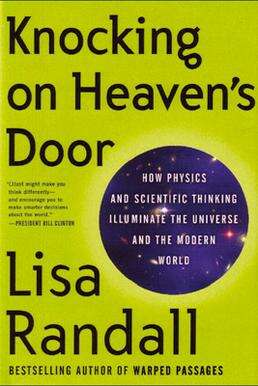Knocking on Heaven's Door (book)
 Hardcover edition | |
| Author | Lisa Randall |
|---|---|
| Language | English |
| Subject | Physics, cosmology |
| Genre | Non-fiction |
| Published | September 20, 2011 |
| Publisher | Ecco Press |
| Publication place | United States |
| Media type | Print, e-book, audiobook |
| Pages | 464 pp. |
| ISBN | 978-0061723728 |
| Preceded by | Warped Passages |
| Followed by | Higgs Discovery |
Knocking on Heaven’s Door: How Physics and Scientific Thinking Illuminate the Universe and the Modern World is the second non-fiction book by Lisa Randall.[1][2][3][4][5] It was initially published on September 20, 2011, by Ecco Press. The title is explained in the text: "Scientists knock on heaven's door in an attempt to cross the threshold separating the known from the unknown."[6]
Review
Randall’s new book, ... takes us 10 years past her initial conjectures and in some ways may be even more ambitious. As the subtitle indicates, she wishes to take up larger questions about the nature of scientific thinking, including its relation to religion and its reliance on probability. At the same time, she wishes to bring her audience up to date regarding the status of her theory within the larger ambit of particle physics and cosmology as the Large Hadron Collider (LHC) begins its work, a monumental collaboration involving the whole world. (Americans are the largest single nationality involved in its operation, although the United States is not an official member state of CERN, its operating consortium.) The resulting book is valuable and engaging; like its predecessor, it is a tour de force of popularization. The good part about its wider ambition emerges in Randall’s clarification of the exact purport and scope of scientific work. But as she interweaves this with descriptions of theories and experiments, past and present, the reader may feel some tension between her somewhat divergent goals, which work together but also divide the reader’s attention and hence lead to organizational challenges.
See also
References
- ↑ "Knocking on Heaven's Door: How Physics and Scientific Thinking Illuminate the Universe and the Modern World by Lisa Randall". goodreads.com. Retrieved 2015-08-20.
- ↑ "Knocking on Heaven's Door by Lisa Randall". harpercollins.com. Retrieved 2015-08-20.
- ↑ HOLT, JIM (October 7, 2011). "Will the Large Hadron Collider Explain Everything?". nytimes.com. Retrieved 2015-08-20.
- ↑ Darracott-Cankovic, Chloe (September 1, 2011). "Knocking on Heaven's Door: How Physics and Scientific Thinking Illuminate the Universe and the Modern World - All becomes clear in an admirable account of the hunt for the Higgs Boson, writes Athene Donald". timeshighereducation.co.uk. Retrieved 2015-08-20.
- ↑ "Knocking on Heaven's Door: How Physics and Scientific Thinking Illuminate the Universe and the Modern World". kirkusreviews.com. May 19, 2011. Retrieved 2015-08-20.
- ↑ Randall, Lisa (2 October 2012). Knocking on Heaven's Door: How Physics and Scientific Thinking Illuminate the Universe and the Modern World by Lisa Randall. HarperCollins. ISBN 978-0061723735.
- ↑ Pesic, Peter. "Exploring Matter and the Cosmos". americanscientist.org. Retrieved 2015-08-20.